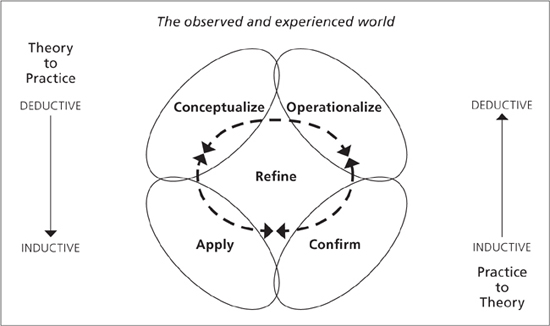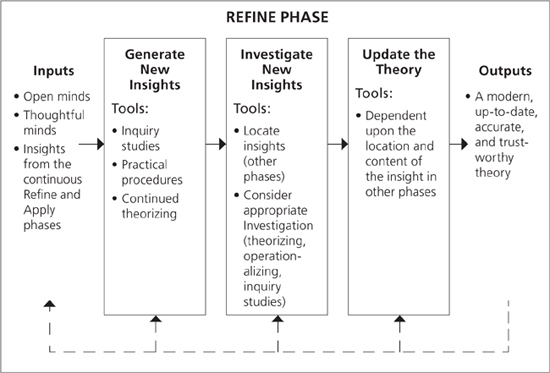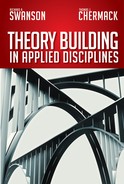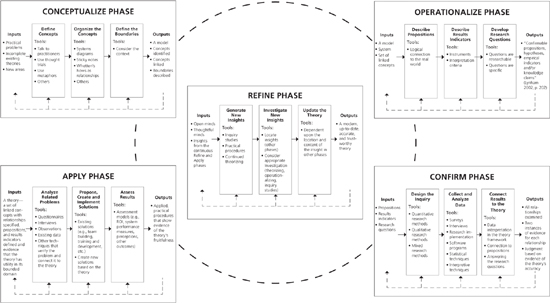8
Refine Phase
THE REFINE PHASE presents a tenacity challenge to the theory builder of applied disciplines. Because of the real-world focus and the ever-changing world, applied theories need to be continually refined to assure their present-day integrity. Thus, the lines between the Apply and Refine phases are blurred. Applied theories are never finished. Theories must undergo continuous assessment of their fit and utility in the ever-changing world of practice. The Refine Phase involves a variety of activities that may push the theorist to revisit all of the other theory building phases. By necessity, the Refine Phase occurs over time. “The intentional outcome of this phase is to ensure that the theory is current and relevant, and that it continues to work in the practical world. It also ensures that when the theory is no longer useful, it is disconfirmed, adapted, or discarded” (Lynham, 2002a, pp. 234). The Refine Phase also marks the ongoing and iterative nature of theory building in applied disciplines.
The purpose of this chapter is to describe specific approaches to the Refine phase of theory building in applied disciplines (Figure 8.1). Specifically, this chapter will
• define the Refine phase,
• describe the general inputs to this phase,
• present a Refine phase case example, and
• describe the outputs of the Refine phase.
FIGURE 8.1 Refine Phase of Theory Building in Applied Disciplines

WHAT IS REFINEMENT?
The Refine phase requires additional efforts in conceivably all the other phases. Continuous refinement of an applied theory is a process keeping the theory under the microscope. Asking questions about its continued integrity and being willing to open up any and all of the theory-building phases in light of the present state of that theory is required.
The Refine phase suggests that a successful theory builder’s work is not done and to settle in for the long term. Given a mature theory, other scholars can enter into the realm with theory such as to confirm or disconfirm it in a new setting or under new conditions, or to reconceptualize the theory. The act of refinement can add to, or challenge, the robustness and utility of the theory.
INPUTS TO THE REFINE PHASE
It may sound trite, but the two most important inputs to the Refine phase are “open minds” and “thoughtful minds.” Because so much effort has already been expended in getting through the other phases, there is a risk of becoming tired and complacent.
Open Minds
The person or team behind the original theory development can get to the point of being too invested in the theory they created. It may be hard for them to pull back. Yet, given objectivity, who else would be in a better position to question, refine, and sustain the theory? Conversely, newcomers to the theory do not have the same stake as the theory originator. Thus, they more likely have the potential of an open mind.
Thoughtful Minds
Thoughtful minds will intelligently assess and question the sum of the theory documentation—strengths and deficiencies. This perspective, along with awareness of changes in practice settings, can guide continuous refinement efforts. The reward is that added insight gained through refinement has great potential in sustaining the life of a theory and in setting its limits.
In addition, the secondary outputs of the Apply phase are direct inputs in the Refine phase. These are the subtleties gained throughout applying the theory in a variety of settings. These various applications suggest ways of potentially modifying the theory. Insights may arise that lead the theorist to consider shrinking the boundary of the theory. Other theorists may wish to engage in a theory-building effort but use an alternative philosophical orientation and research paradigm. Different measurement and assessment tools may be found. All of these may move the theorist into a previous phase of theory building to make adjustments.
REFINE CASE EXAMPLE
In the Refine phase of theory building in applied disciplines, all aspects of the Conceptualize, Operationalize, Confirm, and Apply phases are fair game. There is no one path for approaching refinement. Once an avenue is selected, it will be aligned with one of the theory-building phases. At that point, the guidelines from that specific phase come into play as they did when they were first pursued.
A Refine phase case example from our own work will be used here as an illustration. The example is a theory of performance that was specifically built to explain performance in human systems/organizations that have been created for productive purposes. The origins of the theory of performance are quite modest and evolved over the years through continuous refinement. What follows is a sequential synopsis of evolutionary applied theory-building events that started from a very modest place and matured incrementally with the support of corporate partners.
1. Learning Theory as the Starting Point. XYZ Corporation requested the status theory of learning for corporate trainers to guide them in training decisions. Synthesis of the learning theories and research yielded a simplified three-track learning theory conceptual framework (behavioral, gestalt, and purposive behaviorism) that evolved into the whole-part-whole learning theory. Over the years, operationalization, confirmation, and application have supported and tweaked the whole-part-whole learning theory.
2. Training Systems Theory. XYZ Corporation requested an expansion of the three-track learning theory into a systematic training technology system to be used by the corporate trainers. The training system development effort involved researchers consulting with training and development staff from multiple corporations, with a major decision being made that employee expertise be the primary purpose of training and systematic output.
3. Theory of Work Analysis. Expert and neophyte hourly and salaried workers were interviewed and observed on the job to better understand workplace expertise. A major outcome was the creation of a work theory conceptualization of (1) procedural work, (2) process and troubleshooting work, and (3) knowledge work. Fundamental development and refinement of the theory and methodology tools for analyzing these three types of work behavior expanded the theory realm of work analysis. Researchers carried out preexperimental confirm/disconfirm studies on the three work analysis methods. Dozens of application cases were conducted in XYZ Corporation and numerous other corporations. Incremental changes were incorporated as a result.
4. Economic Theory. XYZ Corporation felt pressure to be able to demonstrate financial return on training and work redesign investments coming out of the theory-driven systematic training and analysis of work expertise. This initiated an articulation of microeconomic theory along with the creation of a performance improvement economic model and method creating the linkage between systematic interventions (not just training) and performance outcomes.
5. Training for Performance System. Based on work analysis theory and economic theory developments, researchers reconceptualized the training system from the training technology system to the training for performance system. Nontraining performance variables in the up-front training analysis and in the follow-up evaluation became part of the system, along with partnering with nontraining personnel for more holistic interventions.
6. Theory of Performance Improvement. The addition of the economic theory development experience, along with the focus on larger system performance as the ultimate organizational outcome, established an expanded boundary deserving of its own theory. At this point, it became performance improvement, with or without training, and a conceptualization of a new theory. The Theory of Performance Improvement, applicable to organizations, drew upon selected psychological, economic, and systems theories and integrated the three into a unique theory. Multiple visual conceptualizations accompanied this applied theory. One is a three-legged stool with each leg representing a component theory leg. Another is a five-level Taxonomy of Performance going from understanding to invention/creation. A Performance Diagnosis Matrix provides conceptual understanding and serves as a data collection and analysis tool. These “thinking” tools are complemented by a series of high-level and detailed process tools that operationalize the performance improvement process. Confirmation came largely through mixed methods case studies in a variety of private and public sector organizations. Application of the theory has resulted in revisions.
This example of theory building in applied disciplines has been abbreviated—hopefully, not abbreviated so much that the sense of adventure, growth, and advancement is lost. The steps and stages were incremental, with periodic bursts of advancement and redirection. The bursts were unexpected gifts.
THE REFINE PHASE OF THEORY BUILDING
The Refine phase features three general steps to consider: (1) generating new insights, (2) investigating new insights, and (3) updating the theory. These three steps require revisiting one or more previous steps of theory building, and the process of addressing these steps is almost always more time-consuming than assumed.
Step 1—Generate New Insights
New insights come from theorizing, research, and practice. The phases aligned with these activities are all four of the preceding phases: Conceptualize, Operationalize, Confirm, and Apply. Insights can come at any time, though they most often emerge when putting the theory into practice in the Apply phase. Insights adding refinement to the theory can be slight and specific, or they can be overwhelming and large scale. Either case requires changes to a theory; and when the changes could be foundational, a choice is made to adjust or start over. Insights from the Confirm phase are specific to the accuracy and fit of the theory with the real world. In other words, they direct the theorist to specific relationships examined in the theory, indicating areas where the thinking may not capture things as they are. Insights from the Apply phase are directly related to the practice of the theory and suggest ways of improving the ability or efficiency of achieving desired changes.
Step 2—Investigate New Insights
The phases of the theory that the new insights affect are important to consider. For example, insights that required changes to the Conceptualize phase will require new thinking about the relationships involved and boundaries. Then measures will need to be identified and tested. On the other hand, insights that suggest changes in the Apply phase require the development of new practical procedures, but do not necessarily require adjustments in any other phase. The complexity of modifications to a theory is directly related to their location in the phases. In any case, when changes to a theory are made, evidence must again be collected about the accuracy.
Step 3—Update the Theory
The goal of the Refine phase is simple: make nonfitting parts of the theory fit. Because fit with reality is the key, any modifications of the theory require the collection of evidence to confirm it. Once confirmed, the theory is updated. There may be follow-up modifications to practical procedures in the Apply phase, but this is entirely dependent on the type of changes.
Summary of the Steps
The Refine phase allows a great deal of freedom to the theorist. The goal is to maximize the accuracy, fit, and confidence of the theory and its connection to the real world. All of the resources and steps in the previous phases are considered fair game, and a theorist is free to move beyond those and use additional approaches as well (Figure 8.2).
Often, this phase requires work in multiple other theory-building phases. Modifying theories is hard work, and there is no prescribed solution. However, the five-phase theory-building framework presented in this book functions as a guide for novice and experienced theorists alike.
FIGURE 8.2 Steps in the Refine Phase of Theory Building in Applied Disciplines

OUTPUTS OF THE REFINE PHASE
The primary output of the Refine phase is a modern theory, meaning it is up-to-date, is congruent with current practices, and continues to show results. This output is straightforward in that the weak and strong spots of the theory have been identified. Constant interplay between this and other phases of theory building result in a theory that is modern and useful.
Another important output of the Refine phase is direction into one or more of the theory-building phases to make modifications. This direction is based on learnings from the Apply and Refine phases. Both of these phases give insights to the theorist that can be used to improve the theory.
QUALITY INDICATORS FOR THE REFINE PHASE
There are no unique quality criteria for the Refine phase of theory building other than criteria carried forward from the other phases. The purpose of this phase is to recognize that theories are never really complete. Their continuous molding and shaping comes from integration of research, theory, and practice and gives the theorist a sense of which area may provide the greatest opportunities for advancing the theory.
Again, the Refine phase ultimately pushes the theorist back to one or more of the other theory-building phases to make improvements that enhance the accuracy or fit of the theory in the real world. If the defined quality indicators in each phase have been used, then the resulting theory will meet the desired results of each phase.
CONCLUSION
This chapter has given structure to the refinement of theories. The Refine phase mandates the continuous improvement of theories and directs the theorist to one or more previous phases in which to make adjustments and improvements. Open and thoughtful minds are required to consider feedback about the utility of theories, especially when the theorist has a hard time stepping back to look at the larger picture. In the end, the theory must aid in the thinking and practice of an instance of human/human systems interaction. The theory and the theorist must be open to adjustment as the surrounding worlds of knowledge and practice are constantly changing.
SUMMARY OF THE FIVE-PHASE GENERAL METHOD OF THEORY BUILDING IN APPLIED DISCIPLINES
The Refine phase completes the presentation of major steps required for sound theory building. Previous chapters have covered each of the other four phases in detail, including guided instruction for applying the tools and concepts we have presented. It is important to realize that the phases are interconnected and work together as a system. In a single graphic, Figure 8.3 illustrates all five phases and the major steps required within each phase.
This representation gives the whole perspective of theory building in applied disciplines. Taken from this point of view, it should be easier to observe that the phases connect directly with each other and that changes in one area require the consideration of changes throughout the other phases. It should also be easy to see that most theory-building efforts are concentrated in one of these phases. By giving structure and definition to each phase, we have raised the bar for what might be called theory. We have also provided tools and frameworks for the challenging and stimulating work of theory building in applied disciplines.
Part Three provides detailed examples of theories that have made the transitions through all of the phases. It also presents a tool for assessing the status of a given theory and lays out explicit suggestions for how to engage in theory building.
FIGURE 8.3 Steps Within All Phases of the Theory Building in Applied Disciplines Method

